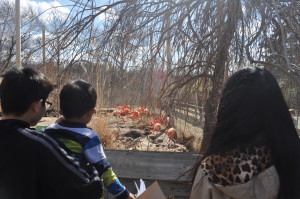Uncaging Imagination with Guerilla Geography

Originally appears in the Spring 2016 issue
Mission One: life can be boring. Drop this article and go outside. Walk around your immediate area. Take note of every detail around you and come back when satisfied with your trek. A learner’s greatest source of inspiration occurs in the community. It starts by taking that first step out the door and seeing how the community reflects what’s being learned in the classroom.
Mission Two: teach with guerrilla geography. This tern provokes several well-known images. The adjective “guerrilla” can be viewed as primitive (with an emphasis on “primate”) or relating to unconventional warfare, like the kind used during the Cuban Revolution. Geography educators created guerrilla geography, a form of place-based education, lending zero thanks to revolucionistas like Che Guevara. It is a free-form approach to education that combats boredom and breaks through comfort zones as it takes learning “to the streets.” Schoolyards, backyards, playgrounds, family dinners, neighborhoods, and public places become spaces of possibility. Learners combine their five senses with memories, emotions, and play to explore meaningful aspects about their local surroundings. Guerrilla geography encourages the learner to be creative and unconventional in their explorations of different places.
This article is an invitation to further infuse guerrilla geography into both informal and formal education systems. As the authors of this article, we have over a decade’s worth of combined experience creating unconventional and practical ways to incorporate geographic learning into educational content both in and out of the classroom. Particularly, we actively work with the National Geographic Network of Alliances for Geographic Education to promote geography education through policy advocacy, pre-service and in-service teacher workshops, research, and outreach to K-12 schools. The idea of guerrilla geography has received much success in places like the United Kingdom and could be used elsewhere in the world. To demonstrate the idealism and practicality of guerrilla geography as a pedagogy, or way of teaching place-based education, we developed our own open-source booklet called Mission: Explore Zoo, Call of the Wild.[i] A free digital copy of this resource can be found on our website provided in the endnotes. The following sections provide guidelines on how to create, implement, and assess your own guerrilla geography learning.
To view the photo-rich magazine version, click here.
If you are not already a subscriber, please subscribe to read the full article
Thomas Larsen is a graduate student of geography at Kansas State University in Manhattan, Kansas. His research interests extend to geography education, environmental perception, and human-environment interaction. Lisa Tabor is an assistant professor at Georgia Southern University, Institute for Interdisciplinary STEM Education. Lisa’s research focuses on best practices in education, enhancing technology use through local authentic learning experiences in the classroom, and improving teacher education/professional development. Both are active members of the National Geographic Network of Alliances for Geographic Education. They can be reached at tblarsen@ksu.edu and lkt7779@gmail.com respectively.
Notes
[i] Larsen, T. and L. Tabor. 2015. Mission Explore Zoo: Call of the Wild. http://www.unexploredgeographic.com/guerrilla-geography.
[ii] Askins, K. and D. Raven-Ellison. 2012. Spotlight on… Mission: Explore Food. Geography 97(3): 163-166.
[iii] The Geography Collective. 2010. Mission: Explore! United Kingdom: The Can of Worms Kids Press.
[iv] The Geography Collective. 2011. Mission: Explore! Camping. United Kingdom: The Can of Worms Kids Press.
Heffron, S.G., and R.M. Downs, eds. 2012. Geography for life: National geography standards, 2nd ed. Washington, D.C.: National Council for Geographic Education.
[vi] Kitchens, J. 2009. Situated pedagogy and the Situationist International: Countering a pedagogy of placelessness. Educational Studies 45: 240-261.
See also Relph, E. 1976. Place and Placelessness. London: Pion.
[vii] Lehman, J. D., George, M., Buchanan, P., and Rush, M. 2006. Preparing teachers to use problem-centered inquiry-based science: Lessons from a four-year professional development project. Interdisciplinary Journal of Problem-based Learning 1(1): 76-99.
Leave a Reply
You must be logged in to post a comment.










